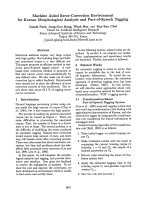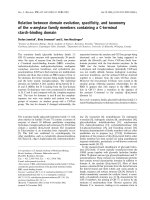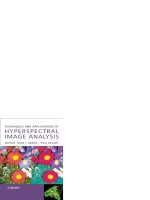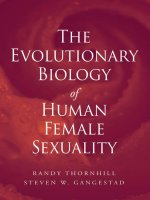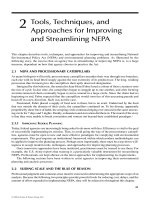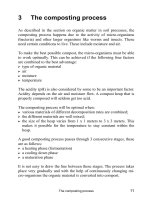MODERN MORPHOLOGICAL TECHNIQUES AND THE EVOLUTIONARY BIOLOGY AND TAXONOMY OF SEPSIDAE (DIPTERA) 2
Bạn đang xem bản rút gọn của tài liệu. Xem và tải ngay bản đầy đủ của tài liệu tại đây (9.31 MB, 27 trang )
101
CHAPTER 5
__________
Using seemingly unnecessary illustrations to improve
the diagnostic usefulness of descriptions in taxonomy
Abstract
Many species descriptions, especially older ones, consist mostly of text and have
few illustrations. This is particularly prevalent in insect taxonomy. Only the most
conspicuous morphological features needed for species diagnosis and delimitation at
the time of description are illustrated. Such descriptions can quickly become inadequate
when new species or characters are discovered. I propose that descriptions should
become more data-rich by presenting an extensive amount of images and illustrations
to cover as much morphology as possible; these descriptions are more likely to remain
adequate over time because their large amounts of visual data may capture character
systems that may become important in the future. Such an approach can now be easily
achieved given that high-quality digital photography is readily available.
Here, I re-describe the sepsid fly Perochaeta orientalis (de Meijere 1913) (Diptera,
Sepsidae) which has suffered from inadequate descriptions in the past, and use
photomicrography, scanning electron microscopy to document its external morphology
102
and mating behaviour. I also used existing video data from a collaborative source
(Evolutionary Biology Laboratory, National University of Singapore; unpublished) to
document the mating behaviour. All images and videos are embedded within the
electronic publication. I discuss briefly benefits and problems with my approach.
103
Introduction
Many species descriptions – especially older ones – are very brief: they
comprise of discussions and illustrations on diagnostic morphology, geographical
distribution, and only occasionally some biology (e.g., see Appendix 3). The
morphology sections are often limited to the most conspicuous features that can be used
to differentiate and identify the target species from other species known to the scientific
community at the time of description. In the past, the main limitation for this
minimalist approach was that journals had tight page restrictions and the cost of
including many illustrations was high; this was a particularly serious problem for
colour and halftone illustrations. Their high cost contributed to the widespread use of
line-drawings in descriptive papers. However, such an exiguous approach towards
descriptions is no longer needed given that these restrictions have largely disappeared.
While line drawings remain crucial for clearly illustrating diagnostic features, a
description can now afford to include more and different types of data. Electronic
journals have fewer limitations on page numbers, and taxonomists now have ready
access to high-resolution photography (Ang et al. 2013) or even µCT (Schneeberg et al.
2012), allowing large amounts of data to be acquired quickly. Furthermore, halftone
and colour illustrations do not incur additional cost in most electronic publications, and
even videos can be embedded in electronic publications, so that primary evidence on
the biology of a species can be included (van Achterberg and Durán 2011).
Embracing these new opportunities has many advantages. One is that more data
makes it less likely that today’s descriptions will be inadequate in the future: the
104
copious use of images to cover as much morphology as possible in descriptions may
serendipitously capture features that will only be revealed to be important in the future.
This does not dilute the importance of line drawings, which have the advantage of
highlighting important features and can accommodate intraspecific variability (see
Discussion). However, only using line-drawings have the disadvantage that they are
unlikely to capture character systems of future importance. For example, 19
th
and some
early 20
th
century entomologists did not anticipate the importance of genitalia and
microtrichosity (pruinosity) patterns in species identification, and did not illustrate or
describe them. Had current-day imaging techniques been available and used by these
taxonomists, genitalia [at least “claspers” (hypopygia)] and microtrichosity data would
have been captured despite their perceived unimportance at the time of description.
Employing these imaging techniques can also protect against bad taxonomy.
For example, Francis Walker (1809–1874), while one of the most prolific taxonomist
of his time was also well known for his poor-quality descriptions and judgement that
resulted in numerous synonyms [as his obituary laments; 'More than twenty years too
late for his scientific reputation, and after having done an amount of injury almost
inconceivable in its immensity, Francis Walker has passed from among us' (Carrington
1874)]. Again, if the inclusion of large numbers of illustrations and images had been
the taxonomic standard in descriptions published in the 19
th
century, many of his “new
species” would not have been published and/or it would have been easier to resolve the
taxonomic problems that were caused by his work.
The use of modern imaging data is slowly beginning to gain traction in
taxonomic work (Neusser et al. 2011), as they are particularly suitable for improving
105
access and dissemination of taxonomic knowledge over the internet. Physically located
resources such as museum specimen trays can now be accessed virtually (Schmidt et al.
2012), digital reference collections in the form of high-resolution images can be
assembled (Ang et al. 2013) and easily curated as well as updated on wiki sites
(Hendrich and Balke 2011). Furthermore, videos, 3D models and other large datasets
can be embedded in PDF files or at least linked as supplementary data (Faulwetter et al.
2013). This is advantageous because it encourages the sharing of different kinds of data
other than morphology (e.g., behaviour, DNA sequences) which can potentially provide
different perspectives on difficult taxonomic issues such as cryptic species complexes
(Tan et al. 2010).
Here, I present a re-description of Perochaeta orientalis (Sepsidae: Diptera)
consisting of morphological, behavioural, DNA sequence, biogeographical, and
biological data. I use them to re-describe the species, include comprehensive external
morphology data by imaging all views of the representative male and female
specimens. In the interests of providing a more holistic description, I also include the
mating behaviour profile along with video data as the result of a collaborative effort
with a fellow lab-mate. This behaviour profile will also contribute to existing records
for other sepsid species, which is crucial for comparative behavioural studies (e.g., see
Puniamoorthy et al, 2009). The re-description of P. orientalis is warranted because the
two existing treatments (de Meijere 1913, Duda 1926) were both inadequate for reliable
species identification. Furthermore, both are old articles written in German and
published in discontinued publications, which limits their accessibility. Note that this
re-description does not affect nomenclature, and that the holotype specimen is
sufficiently well preserved for diagnosing the species.
106
Materials and Methods
Collection and rearing of specimens. All new material was acquired from a
laboratory culture. This culture was established based on a single female adult
specimen collected from a mid-elevation site in Malaysia (Cameron Highlands, 1600m
ASL) and reared based on methods as described in Ang et al. (2008b). For mating
experiments, adult males and females were separated within a day of emergence to
obtain virgin flies. These flies were allowed to sexually mature for three days post-
eclosion before mating trials began. Voucher specimens (in 70% ethanol) used in this
studyare kept in the Raffles Museum of Biodiversity and Research (RMBR), National
University of Singapore, Singapore.
Photography & illustrations. Male and female specimens were extracted from
the culture for re-description. The habitus for both sexes were imaged using the
Visionary Digital™ Plus Lab System (CF4P3 magnification). Several other structures
were also imaged and then digitally transferred into line drawings through tracing with
a Wacom® PTZ 630 tablet in Adobe® Photoshop® CS4. Images and illustrations of
important diagnostic features are shown in Figs. 4.1 and 4.2, while images for
additional views are shown in Fig. 4.3. Images of the holotype (Fig. 4.4) were provided
by the Hungarian Natural History Museum, Budapest, Hungary.
Scanning electron microscopy (SEM). A phallus was dissected and dehydrated
in an alcohol series, then critical-point dried with CO2 (Balzers® CPD-030) and
mounted on a metal stub and platinum sputter-coated (JEOL® JFC 1600 Pt Fine
107
Coater). SEM was performed at 100X with the JEOL JSM 6510 SEM. The image was
then cleaned up with Adobe® Photoshop® CS4, and incorporated into Fig. 4.1.
Mating experiments. Each mating trial involved two male-female pairs (because
they were highly reluctant to mate when only one pair was involved), introduced
simultaneously into a small petri-dish and placed under a Leica MZ16A microscope.
The mating behaviour was then recorded with an analogue video recorder (36 trials).
Recording of behaviour began immediately upon the introduction of specimens into the
petri-dish, and ended after 45 minutes if no mounting attempts made, or if they were
not successful. The recordings were afterwards digitised and the non-linear editing
software Final Cut Pro was used to study the behaviour ‘frame by frame’ (25 f.p.s.) in
order to create a detailed mating profile. This mating profile was then compared with
that of Perochaeta dikowi (Ang et al. 2008b). Video clips of relevant behaviours were
extracted and put together with Window Movie Maker (2012 ver.), and embedded as a
video object in PDF using Adobe® Acrobat® Pro X.
Taxonomic terminology. I adopt the terminology as described by (Merz and
Haenni 2000) for adult non-terminalia morphology and (Sinclair 2000) for genitalia.
108
Results
Perochaeta orientalis (de Meijere 1913)
(Figs. 4.1 – 4.5)
Material examined
Holotype ♂ (Fig. 4.4A). Type locality: "Chip-Chip" (" 集集") Township.
Taiwan, ROC. ♂ in the Hungarian Natural History Museum, Budapest, Hungary.
Additional specimens (Figs. 4.1 & 4.3). Type locality: Brinchang Jungle Trail,
Cameron Highlands, Pahang, Peninsular Malaysia [4°30'9.55"N. 101°23'20.85", 1600m
ASL]. Isoline culture based on ♀ collected 4.I.2011 (R. Meier). ♂♂♀♀ in the Raffles
Museum of Biodiversity Research.
Morphological Diagnosis
Male Perochaeta orientalis is most easily differentiated from other described
Perochaeta species based on the two large, flattened bristles of the main tuft (of which
one has a triangular protrusion sub medially; see red arrow on Fig. 4.1F) on the sternite
appendage. The surstylus in P. orientalis (Fig. 4.1G) is also unique in that the median
inward protrusion is a large, broad-based triangle that spans a third of the surstylus. The
hind tibia of P. orientalis also has a distinct, raised osmeterium (Fig. 4.1C); this is
barely visible or missing in other Perochaeta. Adult female P. orientalis can be
distinguished from P. dikowi based on the presence of sternites 3 and 4 (Fig. 4.2B),
which are missing in the latter.
109
Figure 4.1: Key views and structures of Perochaeta orientalis, Male. A - Habitus, lateral view. B – Pleural
microtomensity pattern; (white = smooth, light grey = lightly microtomentose, dark grey = heavily
microtomentose). C – Rear tibia, with focus on osomterium. D – Basal section of wing showing
microtrichosity pattern (white=smooth, light grey=with microtrichia). E – Whole abdomen, ventral view.
F – Sternite appendage. G – Hypopygial capsule, dorsal view. H – Phallus, right, ventral and left views;
red arrow indicates basal spiny flap. Scale bars = 0.5mm unless otherwise stated.
110
Figure 4.2: Key views and structures of Perochaeta orientalis, Female. A - Habitus, lateral view. B –
Whole abdomen, ventral view. C – Abdominal posterior, ventral view. D – Same, lateral view. E – Same,
dorsal view. Scale bar = 0.5mm.
111
Figure 4.3: Additional views for Perochaeta orientalis, Male (MA-MF) and Female (FA-FE). M and F prefixes refer to male and female specimen respectively. A–
Habitus, dorsal view (sans wings), B – head and thorax, ventral view, C – Head capsule, anterior view, D – Head capsule, posterior view, E – Thorax, posterior view,
F (male only) – Rear tibia, dorsal view showing osmeterium. Scale bars = 0.5mm unless stated otherwise stated.
112
Figure 4.4: Images of holotype (A, B) and drawing (C) from description for Perochaeta orientalis, male.
Image of habitus, lateral view (A). Image of hypopygial capsule, dorsal view (B). Drawing of abdominal
posterior (lateral view) as reproduced from Duda (1926). Red arrow points to medial protrusion on
surstylus. (C); Arrow 1 shows how illustration has fused the two setae into one, Arrow 2 shows how the
drawing fails to display the median protrusion as seen in Fig. 4.1G.
113
Morphological Description
Colour. Similar in males (Fig. 4.1A) and females (Fig. 4.2A). Head capsule
black except for face and a connecting thin strip below the eye, which is light-brown.
Antennae dark brown. Proboscis dark-brown with yellow labellum. Thorax wholly
black, abdomen with glossy dark-brown tergites and sternites. All femora largely
yellow with diffuse obfuscate rings post medially (faint on fore femur). Fore tibia
wholly yellow; mid tibia darkened on the basal half; rear tibia entirely dark. All tarsi
with first two segments yellow and last three dark-brown. Wing cells clear except for
darkened basicostal cell and basal third of costal cell. Veins mostly dark brown.
Calypter creamy; haltere whitish with brown base.
Head. Similar in males and females (Figs. 4.1A & 4.2A). Roundish; facial
carina short and shallow, facial area receding. Gena and parafacial region narrow.
Ocellar prominence and occipital region lightly microtomentose. Chaetotaxy: ocellar
longer than divergent postocellar, 1 outer vertical; inner vertical absent. Orbital very
reduced to absent. 2 vibrissae. 2 – 3 weak postoculars. Lower fascial margin lined with
setulae.
Thorax. Similar in males and females. Scutum, scutellum and subscutellum
lightly microtomentose. Mediotergite microtomentose but glossy in the medial region
(Figs. 4.3ME, 4.3FE). Scutellum twice wide as long (Figs. 4.3MA, 4.3FA). Pleural
pruinosity pattern (Fig. 4.1B): Protonotopleural lobe glossy on pleural region but
microtomentose on dorsal region. Proepisternum fully microtomentose. Anepisternum
largely glossy with anterioventral region densely microtomentose. Katepisternum with
114
dense tomentosity except for glossy anterioventral region. Anepimeron glossy with
lightly microtomentose strip on posterioventral region. Katatergite, katepimeron,
metakatepisterum, meron and metepimeron lightly-dusted. Chaetotaxy: 1 apical
scutellar, 1 reduced, setulae-like basal scutellar, 1 dorsocentral, 1 postalar, 1
supraalar, 2 notopleural, 1 postpronotal, 1 anepisternal and 1 posterior spiracular.
Postpronotoum, prescutum and anepisternum with few, sporadic setulae.
Legs. Forelegs unmodified in males and females; all femora and tibiae without
robust setae except for a longitudinal row of short spines on the anterior basal half of
mid femur. Male rear tibia with a small but distinct osmeterium with raised hairs at the
posteriodorsal region, and with three enlarged ventral setae on basitarsus (Fig. 4.1C).
Females similar but lacking in osmeterium.
Wings. Similar in males and females. Slender. Without apical pterostigma.
Veins bare. Wing microtrichia pattern (basal half; Fig. 4.1D): cells covered with
microtrichiae except for subcostal, basal-medial, posterior-cubital cells and alula.
Costal, radial 1, radial 2+3, radial 4+5, basal-radial, disco-medial, anterior cubital cells
and anal lobe with portions lacking microtrichia. Radial-medial cross-vein divides
discal-medial cell by ratio of 2 : 1. Length: 4.4 – 4.8 mm.
Male abdomen. Ventral view (Figs. 4.1E & F). Syntergite 1+2 to tergite 5
normal, tergite 6 missing, syntergite 7+8 present and extending ventrad as a narrow
sclerite. Spiracles 1 – 4 on intersegmental membrane, spiracle 5 on ventral margin of
tergite 5, spiracle 7 and 8 adjacent on margin of syntergite 7+8. Sternite 1 as a thin
lateral band with tapering ends while sternite 2 is triangular, tapering posteriorly;
115
sternite 3 is longitudinally oblong. Sternite 4 heavily modified into paired moveable
appendages [Fig. 5.1F; see Bowsher et al. (2013) for a discussion on the evolution of
the appendages and Ang and Meier (2012) for sternite appendage illustrations of other
Perochaeta]: largely desclerotized except for anterior margin as well as two rectangular
regions laterally off the median. Two stout moveable appendages (=sternite brushes;
indicated by red arrows) branch off laterally, each with a tuft of small short bristles
facing the inner side of the sternite and two large, flattened and inward-curving bristles
on the apices, of which one is pinched sub medially, resulting in a tooth like furcation
on the inward side.
Hypopygial capsule (Fig. 4.1G). Cercal plate with two very weak lobes, each
with one setae. Hypopygial capsule triangular with a large tooth-like projection on the
inner side basal to where the surstylus branches off. Surstylus itself fused to hypopygial
capsule and branches off dorsally. Each surstylus is curved ventrally, with a large,
flattened triangular protrusion inwards; terminus with “teeth” and setulae.
Phallus (Fig. 4.1H). Basal region with scales on left side and relatively smooth
on right side (crinkles and cracks on the surface are due to drying artifacts). A large
flap from the basal region, and is adorned with numerous long spines. Distal portion
short (ca. 1/3 of basal portion) and membranous. I refrain from assigning terminology,
for reasons explained in Discussion.
Female abdomen (Fig. 4.2B - E). Syntergite 1+2 – tergite 5 similar to male,
tergites 6 and 7 well defined and sclerotized. Spiracles 1 – 5 in intersegmental
membrane while spiracles 6 and 7 are within the tergites. Sternites 1 and 2 similar to
116
male, sternite 3 as a very thin longitudinal strip. Sternite 4 also a thin strip with barely
visible sclerotization and a diffuse margin, sternite 5 missing. Sternites 6 as a lateral
rectangle and sternite 7 tapering posteriorly. Postabdominal segments 6 and 7 with the
tergites and sternites separated laterally, the sternites (like the tergites) thus very broad
and short; segment 8, when not invaginated, long, extended posteriorly and ventrally,
with a ventral element (sternite 8) on each side that remains separated at tip and a
dorsal element (tergite 8) that forms the usual pair of ring-like bars that do not quite
touch apically. Cercus small and round, with hypoproct present, bare. Internally, two
spermathecae present, one twice as large as the other.
Mating Behaviour
Here, 36 mating trials with virgin males and females were conducted in
collaboration. Only two of these trials were successful (=5.6% mating success rate),
and the copulation time for these two were ca. 75 and 72 minutes. Virgin mating
behaviour can be categorised into four sections: (1) courtship, (2) approach and mount,
(3) copulation and (4) separation. The copulatory profile (section 3) for P. orientalis is
shown in Fig. 4.5, based on a frame-by-frame analysis of one of the trials. All described
behaviours are shown in Video 1 (time in video given as mm:ss. please refer to CD or
view it on either Youtube: or download clips at
Where available, I will compare and differentiate P. orientalis
behaviours with P. dikowi (Ang et al. 2008b) as it is the only other Perochaeta with
described behaviour. My efforts to provide a detailed mating behaviour profile for P.
orientalis is part of a larger series of papers investigating of mating behaviour in
117
sepsids (e.g., Ang et al. 2008b, Puniamoorthy et al. 2008, Puniamoorthy et al. 2009,
Tan et al. 2010, Tan et al. 2011). Here, attention to detail is important, given the
species-specific nature of sepsid mating behaviour (Puniamoorthy et al. 2009).
Courtship. When the male detects and shows interest in a female, they perform
the courtship behaviour “wing flutter dance”, where he rapidly circles the female from
his side while fluttering the wing facing the female (00:07). This behaviour is not
observed in P. dikowi.
Approach and mount. The male will approach the female from the rear and
attempt to mount her. Unlike most sepsid species, P. orientalis males lack modified
forelegs, and do not clasp the female wing or perform pre-copulatory behaviours when
mounted like other sepsids (Puniamoorthy et al. 2008). Instead, he mounts similarly to
P. dikowi; using his fore tarsi to hold on to the female’s abdomen whilst bending his
abdomen forward. He then extends his sternite brush to contact the genital region,
while the surstylus attempts to clasp the female genitalia (00:15 & 00:29). A crucial
difference between the two species is that P. dikowi uses his sternite brush to contact
the anterior portion of the female abdomen before sliding towards her posterior, while
P. orientalis immediately contacts the genital region (see attempt in 00:15). At this
stage, females are documented to be highly resistant towards the males (thus resulting
in the low mating success rate). This resistance manifests as kicking males away with
their mid and rear legs and/or raising their abdomen to prevent genital contact (00:15).
Females are generally able to resist males, and in the two successful mate trials, the
males were able to mount and establish genital contact because the females did not
118
resist (00:29). Such intensity of female resistance was not recorded in P. dikowi, which
had a higher mating success rate (28.6%).
Video 1: Video montage for the various behaviours described. Section 1, Courtship: Male wing-flutter
dance (00:07). Section 2, Approach and Mount: Failed attempt with female resistance, lateral view
(00:15), Successful mount, dorsal view (00:29). Section 3, Copulation: M1 Male foreleg tap to female
head (00:41), M2 Male rear leg rub (01:03), M3 Male rear- to mid-leg rub (01:10), M4 Male mid legs
tap to female wing (01:18), M5 Male mid legs tap to female abdomen (01:29), F1 Female resistance
(mid legs push) (01:39), F2 Female resistance ( rear leg push) (01:51), F3 Female grooming ( rear leg
rub) (02:00), F4 Female grooming (foreleg-head rub) (02:06). Section 4, Separation (02:15)
NOTE: This is video-based content; please refer to CD or view it on either
(1) Youtube:
(2) or download clips at
119
Figure 4.5: Copulatory profile for Perochaeta orientalis, as described in Section 2 (Copulation) Horizontal bars in graph indicate point in time (X-axis) where then the
particular behaviour (Y-axis) is performed. The profile begins from when the male mounts the female, and ends when they begin to separate (total time = 72m
30s).otherwise stated.
120
Copulation. This section is represented in Fig. 4.5. Once the male has locked
genitalia with the female, they can copulate for 73.7±1.2 min (based on the two
successful mating trials), which is over 3 times longer than that in P. dikowi (22.6±2.48
min). Copulation switches between periods of rest and activity. During rest, males
place their fore tarsi on the female pronotal callus while mid- and rear legs are splayed
out. During active periods, the male displays five types of behaviours: “M1: fore leg
head tap” – males using fore tarsi to tap repeatedly on female head( 00:41), “M2: rear
leg rub” – males rubbing rear legs together (01:03), “M3: rear-mid-leg rub” – males
rubbing rear legs with mid legs (01:10), “M4: mid legs wing tap” – males using mid
legs to tap repeatedly on female wing (01:18) and “M5: mid legs abdomen tap” – males
use mid legs to tap repeatedly on female abdomen (01:29). Behaviours M3 and M4
mostly occur after M1 and M2, suggesting a transfer of substance from the rear tibial
osmoteria to the mid legs and then onto the female wing and/or abdomen. Female
resistance was also recorded some time after copulation was initiated; the female
mostly used her mid legs to push against the male (F1; 01:39), while the rear legs were
used less frequently (F2; 01:51). The female also indulged in grooming herself at times,
either performing a rear leg rub (F3; 02:00) or a fore leg-head rub (F4; 02:06).
Separation. Just prior to separation, the male engages ‘active’ copulation,
performing the ‘fore leg head tap’ as well as the consecutive ‘rear-mid-leg rub’ and
‘mid legs abdomen tap’. The separation event itself is observed to be initiated by the
male, where he turns 180° and pulls away from the female (02:15). Both males and
females will also use their rear legs to push against each other during this time. This is
similar in P. dikowi.
121
Distribution, laboratory records and DNA sequence information
Biogeography. Perochaeta has been consistently found only in mid- to high-
elevation areas [see Ang and Meier (2010) for a discussion on the genus’s
biogeographical distribution]. P. orientalis itself was first described from two township
localities in the central highlands of Taiwan: “Chip Chip” (=集集) and “Polisha” (=埔
里) (de Meijere 1913). It is thus possible that P. orientalis – like its congeners – is a
higher-elevation specialist limited to the hills and mountains of the oriental region. It
has been recorded in Taiwan, Indonesia (Sulawesi I.), East and West Malaysia, as well
as the Philippines (Luzon I., Mindanao I.) (Ozerov 2005).
Laboratory records. Under laboratory conditions, P. orientalis has been bred
successfully from bovine (cow and guar) dung. They are also attracted to this substrate
in the wild, which makes sampling an area for Perochaeta a “bait-and-wait” strategy.
DNA sequence information. Molecular data from my new P. orientalis material
are presented as part of the updated sepsid phylogeny (Lei et al. 2013). Nine
mitochondrial and nuclear genes have been sequenced and uploaded to Genbank. Their
accession numbers are: 12S - KF199478, 16S - KF199525, COII - KF199667, COI -
KF199842, CYTB - KF199714, 18S - KF199572, 28S - KF199618 ATS - KF199795,
H3 - KF199739. Genetic distances for COI between existing species with DNA records
(P. cuirassa, P. dikowi and P. lobo) were calculated using Species-IDentifier (Meier et
al. 2006). Perochaeta orientalis has the most similar sequence to P. dikowi (3.82%;
Table 4.1), a distance that is well in excess of what is normally found between dipteran
species (Meier et al. 2008).
122
Table 4.1: A summary of the pairwise distances between the COI of P. orientalis with that of P. cuirassa
(KF199839), P. dikowi (KF199840) and P. lobo (KF199841). Perochaeta orientalis has the most similar
sequence to P. dikowi’s (3.82%), and all pairwise distances are relatively high.
P. orientalis P. cuirassa P. dikowi P. lobo
P. orientalis
0.00%
11.44%
3.82%
13.15%
P. cuirassa
8.70%
0.00%
12.95%
11.89%
P. dikowi
11.89%
12.95%
0.00%
8.70%
P. lobo
13.15%
3.82%
11.44%
0.00%
Discussion
Concordance with precedent descriptions and holotype. The decision to re-
describe P. orientalis was based on the quality and accessibility of the two precedent
descriptions by de Meijere and Duda (Appendix 3). de Meijere’s description (1913)
was a short paragraph written in German, devoid of illustrations, and published in a
journal that has since been discontinued. It presented a relatively inaccessible source of
information that was also grossly insufficient for reliable species diagnosis. Duda’s re-
description (1926) was much more detailed, but only one illustration was presented
which lacked clarity (Fig. 4.4C). For example, while it did show the two long, flattened
setae found in P. orientalis, they were drawn fused at the base as a single bifurcated
seta (Arrow 1). The hypopygial capsule was also drawn in such a way that it failed to
illustrate the large median triangular protrusion on the surstylus (Arrow 2; cf. Fig.
4.1G). In this case, much effort went into text instead of illustrations, which still
resulted in an unclear species diagnosis. It was only through the re-imaging of holotype
specimen (Figs. 4.4A & B) that I was able to determine that my material was indeed P.
orientalis, based on the lateral thoracical microtrichosity pattern (c.f. Figs. 4.1A &
4.4A), the bristle morphology on the sternite appendage (arrow on Fig. 4.4A, which
123
shows two overlapped flat bristles similar to that in Fig. 4.1F) as well as the large
median protrusion on the surstylus (arrow on Fig. 4.4B, c.f. Fig. 4.1G); i.e., a
photographic image of the holotype would have been much more informative than the
line drawing of the same specimen. Note that this re-description does not affect
nomenclature, and the holotype specimen remains well-preserved enough for a proper
diagnosis of the species.
Figure 4.6: Illustration of Archisepsis phallus, as reproduced from Eberhard and Huber (1998). Red
arrow indicates region that may be homologous to the basal spiny flap in P. orientalis.
The phallus as anticipatory data. In this paper I include images of the
unlabelled phallus (Fig. 4.1H). There is still a dearth of information on this structure in
Sepsidae, but I anticipate that it will gain in importance in the future. It is well-
recognised that insect genitalia evolve rapidly and divergently, and are often the most
reliable characters to delimit and describe species (Eberhard 1985). However, the
phallus is almost never described in Sepsidae because it is often inaccessible without
124
dissection and slide preparation, and species identification can be accomplished using
the more exposed genitalia (e.g. hypopygial capsule) and other secondary sexual
characters [e.g., forelegs and modified sternites (Pont and Meier 2002)]. A review of
current literature revealed only two publications that have dealt with the sepsid phallus
(‘aedeagus’) in detail. Here, the authors have either refrained from textual description
and terminology entirely (Zuska 1965) or resorted to using informal terms such as
'spiny tongue', 'long finger' and 'oxtail' [Fig. 4.6 (Eberhard and Huber 1998)].
Furthermore, because the phallus is very variable between species and genera, it
is difficult to homologise phallic structures between species. For example, the large
spiny basal flap in P. orientalis (red arrow, Fig. 4.1H) might be homologous to the
unlabelled flap in Archisepsis (red arrow, Fig. 4.6) but more species need to be studied
before this hypothesis can be supported. This problem is not limited to Sepsidae: a
taxonomic review of the kelp fly family Coelopidae (McAlpine 1991) expressed little
confidence in the homology of his proposed phallus terminology, and only applied
terms so that he could describe the morphology. As such, I present the SEM images for
the P. orientalis phallus only as ‘anticipatory’ data for a character system that will only
become fully available in the future.
Costs and benefits of a data-rich description. In my re-description, I abundantly
describe the morphology of P. orientalis with line drawings, photography and SEM
images. All this visual data was produced within a day, while much more time was
spent on acquiring access to the original type material, literature, and confirming
species identity. Of course, one of the obvious questions that are raised by my proposal
is how much information should be presented for a species? While I have covered the
125
external morphology with images, my treatment is far from exhaustive. For example, I
did not investigate internal morphology, nor the cuticular hydrocarbon profile (Kather
and Martin 2012), near-infrared spectroscopy and chemometry (Rodríguez-Fernández
et al. 2011) and optical reflectance patterns (especially on wings; Shevtsova et al.
2011), which the latter two are known to be species specific in some insects. I also only
display one specimen of each sex (in addition to the holotype), which may not represent
the intra-specific variability. The amount of data to be presented in a description is
ultimately up to the author and determined by the tradeoffs between the costs (either in
time, or resources) of acquiring the additional information and its potential use. Yet,
within the last decade we have seen rapid advancements in digital photography and
decreases in the cost of acquiring and publishing imaging data. This has led to the
much more widespread use of photographs in taxonomic manuscripts. However, I
argue the focus has been too much on illustrating those structures that are already
known to be important. Let us be more visionary by illustrating as much morphology as
possible to anticipate what may become important in the future.
One may argue that this will add to the taxonomic impediment, because
descriptions employing my proposed approach would require more images. This is a
legitimate concern, given that taxonomists are already overwhelmed with the amount of
undescribed species (Riedel et al. 2013). However, there is a difference between long
texts which do require significant effort to produce and are often of limited value and
descriptions that are abundant in illustrations which can be generated in relatively short
amounts of time. For example, with proper equipment, staff can produce 40 high-
quality images per day (Tegelberg et al. 2012). Descriptions can then be prepared
quickly when data is presented in an easy to access manner (e.g., as high-resolution

